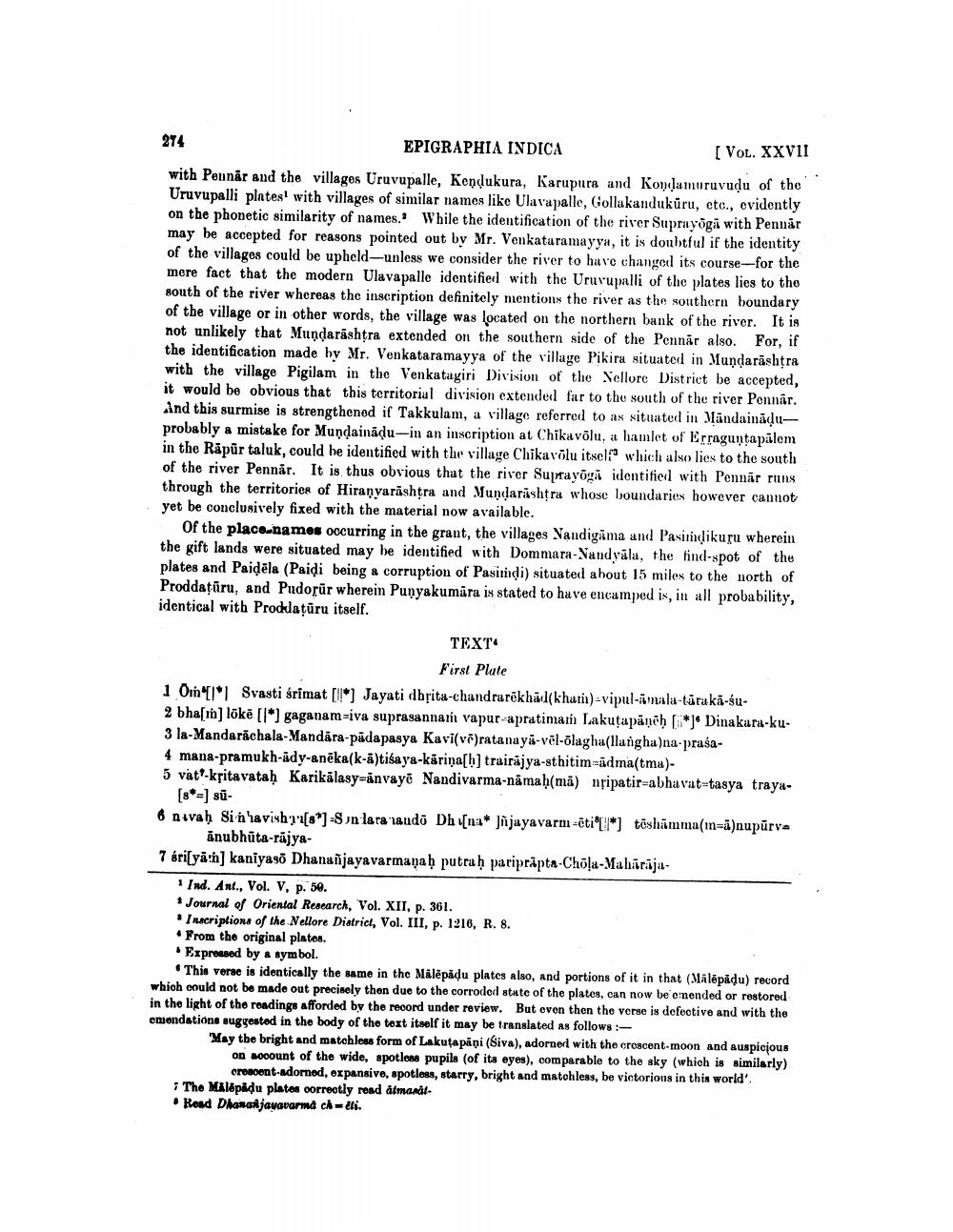________________
274
EPIGRAPHIA INDICA
[VOL. XXVII with Pennar and the villages Uruvupalle, Kenḍukura, Karupura and Kondamuruvudu of the Uruvupalli plates with villages of similar names like Ulavapalle, Gollakandukuru, etc., evidently on the phonetic similarity of names. While the identification of the river Suprayoga with Pennar may be accepted for reasons pointed out by Mr. Venkataramayya, it is doubtful if the identity of the villages could be upheld-unless we consider the river to have changed its course-for the mere fact that the modern Ulavapalle identified with the Uruvupalli of the plates lies to the south of the river whereas the inscription definitely mentions the river as the southern boundary of the village or in other words, the village was located on the northern bank of the river. It is not unlikely that Mundarashtra extended on the southern side of the Pennär also. For, if the identification made by Mr. Venkataramayya of the village Pikira situated in Mundarashtra with the village Pigilam in the Venkatagiri Division of the Nellore District be accepted, it would be obvious that this territorial division extended far to the south of the river Pennar. And this surmise is strengthened if Takkulam, a village referred to as situated in Mandainaḍuprobably a mistake for Muṇḍainadu-in an inscription at Chikavõlu, a hamlet of Erraguntapalem in the Rapur taluk, could be identified with the village Chikavõlu itself which also lies to the south of the river Pennår. It is thus obvious that the river Suprayoga identified with Pennar runs through the territories of Hiranyarashtra and Mundarashtra whose boundaries however cannot yet be conclusively fixed with the material now available.
Of the place names occurring in the grant, the villages Nandigama and Pasindikuru wherein the gift lands were situated may be identified with Dommara-Nandyala, the find-spot of the plates and Paidēla (Paidi being a corruption of Pasindi) situated about 15 miles to the north of Proddaturu, and Pudorür wherein Punyakumara is stated to have encamped is, in all probability, identical with Proddaṭūru itself.
TEXT First Plate
1 Om
Svasti śrimat [*] Jayati dhṛita-chandrarekhad(kham)-vipul-mala-tārakā-su
2 bha[in] lōke [*] gaganam-iva suprasannam vapur-apratimai Lakuṭapaneḥ [*] Dinakara-ku
3 la-Mandarachala-Mandara-padapasya Kavi(vē)ratanaya-vel-ōlagha(llangha)na-prasa
4 mana-pramukh-idy-anēka(k-)tidaya-kāriṇa[b] trairajya-sthitim-idma(tm)
5 vat-kritavatah Karikálasy-invayê Nandivarma-namaḥ(mā) nṛipatir-abhavat-tasya tray[8*=] sū
6 navah Sinhavishy[a]-8n laca auds Dh[ns Jijayavarm-titshämma(m=å)nupārv anubhūta-rajya
7 ariyah] kaniyas Dhananjayavarmayah putraḥ paripeäpta-Chōla-Mahārāja
1 Ind. Ant., Vol. V, p. 50.
1 Journal of Oriental Research, Vol. XII, p. 361.
Inscriptions of the Nellore District, Vol. III, p. 1216, R. 8.
From the original plates.
Expressed by a symbol.
This verse is identically the same in the Malēpāḍu plates also, and portions of it in that (Mälēpādu) record which could not be made out precisely then due to the corroded state of the plates, can now be emended or restored in the light of the readings afforded by the record under review. But even then the verse is defective and with the emendations suggested in the body of the text itself it may be translated as follows:
May the bright and matchless form of Lakutapāņi (Siva), adorned with the crescent-moon and auspicious on account of the wide, spotless pupils (of its eyes), comparable to the sky (which is similarly) crescent-adorned, expansive, spotless, starry, bright and matchless, be victorious in this world'. The Malapadu plates correctly read atmasalRead Dhananjayavarma ch➡éli.




